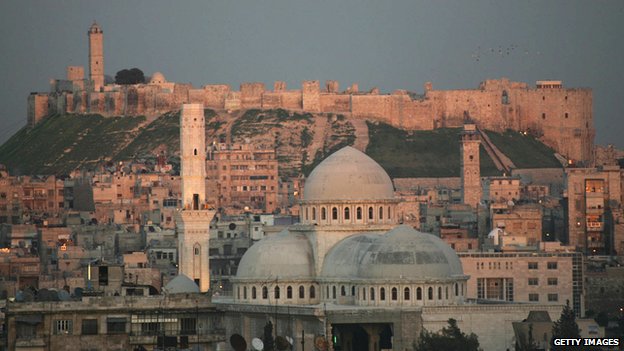Syria is the cradle of civilization and the point of attractions for visitors, including VIPs. Away from official protocol and formalities, H.M. Queen Sofia of Spain made a private visit to Syria in the period 29/10 to 3/11 / 2004.It was evident that the scent of the Damascene Jasmine and the odor of the Aleppo heritage infiltrated to the heart of the charming queen who had just recently made a state visit to Syria, so she wanted to deepen her memories of this wonderful country and came back again accompanied by some of her dearest kins.
In Aleppo she started the visit in one of the old quarters of Aleppo, H.M. personally, chose her residence in an old typical Syrian house newly renovated to preserve its original design and decor in order to be transferred into a tourist residence. After a short rest, the Queen made a tour in the old bazaar of Aleppo and enjoyed the peaceful atmosphere of the place which was highly influenced by the religious month of Ramadan, which reflected the spirit of intimacy, generosity and originality of the Syrians. Her Majesty was briefed about the history and development of the bazaar in particular and about the old city of Aleppo in general. Shopkeepers gave her details about parts of the bazaar, its sections, the Khans (hostels) spread around and the gates of the city. She reviewed Bab al Nasr, (the Victory Gate), then She visited the famous historical Hotel Baron, whose golden record included the names of several historical personalities who, in different periods of history were prominent clients of the hotel.
The Queen ended her visit to the old city having dinner in one of the public restaurants, like any other Syrian citizen. In her second day in Syria H.M. visited the citadel of Aleppo, explored it part by part, especially the royal bath, and the hall of the throne of Saladin, and she personally photographed them by her own camera. Then she continued her tour on foot and visited the handicraft bazaar from where she bought souvenirs and gifts to her kins and friends. Then She entered one of the typical popular cafes to drink local tea, where she was welcomed with applause and cheerful greetings. After tea, the Queen visited the “Museum Of Popular Traditions, and the churches around the museum. In the Syriac Orthodox Church the choir of the church welcomed her majesty and offered several religious hymns that reflected the religious spirit and devotion of the people of Aleppo.
The third day of the visit was busy. The Queen left Aleppo to visit the region of the dead cities where she visited the village of Sheikh Suleiman. She toured the village and visited its churches, then left to the cathedral of St. Simeon and spent some time of meditation in the pine groves of the old place. On her way back to Aleppo H.M. stopped in the ancient village of “Kimar., and visited the ruins of its church. In Aleppo she visited the “Arghoni Bimarestan. (An old hospital now used as a museum) where a traditional dervishes§ troop played and sang several pieces of the Soofi music and local melodies, which the Queen admired. Before leaving Aleppo, H.M. visited two of the oldest mosques in the city; al A’del Mosque and the Umayyad Mosque, where She was briefed about their history and the program of restoration being executed to preserve them as national heritage. She stood long in front of the Mausoleum of Zachariah and the ‘solar clock§ in the court of the Umayyad mosque.
Just opposite to the mosque, She visited al Madrasa alHalawia and then toured the local bazaar where she exchanged speeches with the vendors of the typical foods and beverages of the holy month of Ramadan. In a surprising initiative companions of her majesty celebrated her birthday and offered her gifts in the occasion. To go to Damascus and enjoy the trip, Queen Sofia preferred to have a mini bus rather than an aircraft, so that she can explore the Aleppo – Damascus road and to visit some important locations along the road like the monastery of St. Taqla of Ma’aloula. In Damascus She visited the tomb of Saladin, then the Umayyad mosque where H.M. attended the Moslem evening prayers of Ramadan (al Taraweeh), then she toured Souk al Hamidiyeh. In the Meridian Hotel, her residence in Damascus, H.M. received H.E. president Bachar al Asad and his wife who accompanied her in a private tour in Old Damascus. Queen Sofia ended her first day in Damascus in the National Museum where she reviewed hundreds of historical treasures of the museum, especially those of Ebla. In her second day in Damascus, Queen Sofia, accompanied by Mrs. Asma’a al Asad, wife of the Syrian president, toured al Takieyah al Suleimanieh and the handicraft bazaar of Damascus. They listened to briefings about the history of the place and the nature of the bazaar, then they visited the Church of St. Ananya and the church of St. Paul and thanked the people who stood in lines to greet them.
Ending her visit to Syria, H.M. and the accompanying delegation, expressed their pleasure and happiness of the visit, thanked the president and his wife and the Syrian people for the hospitality and generosity they met in Syria. Far from official protocol and formalities, H.M. Queen Sofia of Spain made a private visit to Syria in the period 29/10 to 3/11 / 2004.
Haifaa mafalani

